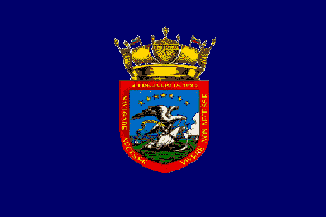
image by Guillermo T. Aveledo, 19 December 1999

Last modified: 2006-03-18 by dov gutterman
Keywords: venezuela |
Links: FOTW homepage |
search |
disclaimer and copyright |
write us |
mirrors
See also:

image by Guillermo T. Aveledo, 19 December 1999
The Navy (Armada de Venezuela ) flag is the Coat of Arms of
the Navy, on a blue field.
Guillermo T. Aveledo, 19 December 1999
According to Lacasadelasbanderas.com,
there is an inscription on the flag.
Dov Gutterman, 23 June 2001
 (2:3)
(2:3)
image by Pascal Gross, 13 December 2006
The naval ensign of Venezuela is the national flag with the
Coat of Arms in the upper left corner.
Source: Christian Fogd Pedersen - Flaggor i färg, 1973
[ped73].
Marcus Wendel , 15 September 1999
The huge flag depicted on a picture of the School Ship A.R.V.
"Simon Bolivar" is used for special ocasions. According
to the Diccionario Enciclopedico Ilustrado de la Lengua Espanola
Sopena (Barcelona, 1954), this flag fall under the name of
"bandera de combate" or 'combat flag'. I translate the
term: a national flag, very large sized, which hoisted over the
stern of warships when they go into battle or in very solemn
events. As of today, Venezuelan ensings have larger and bolder
stars, so as to be seen from afar and not be confused with
Colombian or Ecuatorian flags.
Guillermo Aveledo, 29 September 2000
Pre-2006 Ensign
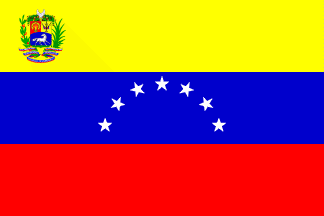 (2:3)
(2:3)
image by Željko Heimer, 18 August 2003
See also: National and State Flag
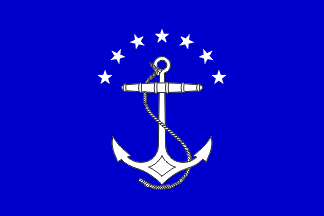 (2:3)
(2:3)
image by Željko Heimer, 20 August 2003
Torrotito/Venezuelan Jack - According to the Naval Ceremonial
and Protocol Regulations number MAN-EC-CGA-0001-B effective since
July 1st, 1997.
Raul Orta, 18 May 2002
According to Album 2000 Corr. 3 [pay03]
- Jack (2:3) - Blue flag with white fouled anchor and severn
fivepointed stars in an arc above. I have no exact data, but it
seems to me that this jack could originate from, say 1950's, as I
know of no earlier sources showing one. Actually my sources here
are all after 1995 (Albums mainly). Possibly a variant with
simplier artistic representation was used before 1990's? (this
may indicate somewhat diffferent flags for rank flags in 1995
Album issue.)
Željko Heimer, 20 August 2003
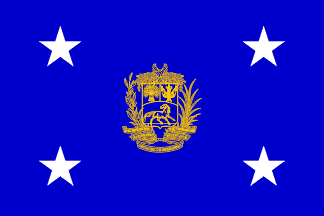 (2:3)
(2:3)
image by Željko Heimer, 22 August 2003
Ministro de la Defensa / Minister of Defense - According to
the Naval Ceremonial and Protocol Regulations number
MAN-EC-CGA-0001-B effective since July 1st, 1997.
Raul Orta, 18 May 2002
According to Album 2000 Corr. 3 [pay03]
- Minister of Defence (2:3) - Blue flag with the coat of arms
lined with gold lines only and four white five-pointed stars, one
in each corner.
This is, as far as I understand, flag prescribed for display on
naval ships when MoD is present. This must have been adopted in
1997, since earlier sources show an other one for this purpose -
though similar with all-white Coat of Arms in the middle.
Album also show: Minister of Defence (car flag) - Silver flag
finged in gold on three sides with the emblem of the Ministry of
Defence in the middle and golden inscription arched above and
below MINISTERIO DE LA DEFENSA / REPUBLICA BOLIVARIANA DE
VENEZUELA. As it is labeled, this is a flag used as car flag, but
probably also as the flag/colour of the Ministry as a whole.
Crampton's [cra90f] described
Minister of Defence as blue with a styized anchor within 4 stars,
all white and the arms in the canton. The MoD flag is unusual
with the Coat of Arms in the canton! What exactly did Crampton
mean - wouldn't the Coat of Arms cover one star then?
Željko Heimer, 22 and 29 August 2003
Flag at Original Album 2000
 (2:3)
(2:3)
image by Željko Heimer, 26 August 2003
In the original Album 2000 [pay00]:
Minister of Defence (2:3) - Blue flag with white coat of arms
(lined black) in the middle and four white five-pointed stars one
in each corner. The corr. 3 introduces the golden coat of arms
instead, but weather this is an older pre-1997 pattern or only an
errorneus representation, we may never know.
Album 95 [pay] is similar to Album
2000, but the blue used is notably lighter (as also in all
subsequent flags), but I do not know how important that is. The
flag ratio is drawn as close to 3:4, the ratio that Album 2000
and corr. 3 retain in the images, but provide textually 2:3.
Željko Heimer, 26 and 28 August 2003
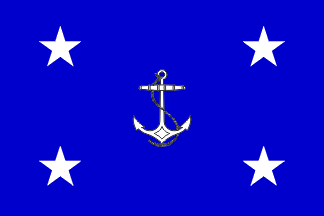 (2:3)
(2:3)
image by Željko Heimer, 22 August 2003
Naval flags of Venezuela in accordance with . Commander
General of the Navy is quoted in Pavillon 2001 as 2:3 but
measure 4:5.
Martin Grieve, 7 May 2002
Comandante General de la Armada / Commander General of the
Navy - According to the Naval Ceremonial and Protocol Regulations
number MAN-EC-CGA-0001-B effective since July 1st, 1997.
Raul Orta, 18 May 2002
According to Album 2000 Corr. 3 [pay03]
- Commander General of the Navy (2:3) - Blue flag with a white
fouled anchor in the middle and four white five-pointed stars,
one in each corner.
The drawing show flag as 3:4, so distorting it to 2:3 does not
provide for more detailed analysis of the size and disptibution
of the elements.
Željko Heimer, 22 August 2003
Flag at Original Album 2000
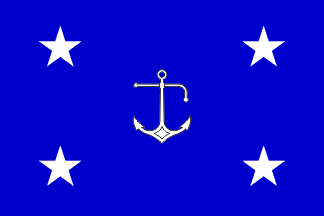 (2:3)
(2:3)
image by Željko Heimer, 26 August 2003
In the original Album 2000 [pay00]:
Commander General of the Navy (2:3) - Blue flag with white anchor
in the middle and four white five-pointed stars one in each
corner. The corr. 3 showes here very similar flag, the difference
being only in the artistic representation of the anchor. Is this
older version, or simplification made by authors copying from
each other?
The remaining naval rank flags of this pattern (for admirals)
already show the anchor patter used latter. Was there a previous
verison with the anchor as in this flag?
Album 95 [pay] is similar to Album
2000, but the blue used is notably lighter (as also in all
subsequent flags), but I do not know how important that is. The
flag ratio is drawn as close to 3:4, the ratio that Album 2000
and corr. 3 retain in the images, but provide textually 2:3.
Željko Heimer, 26 August 2003
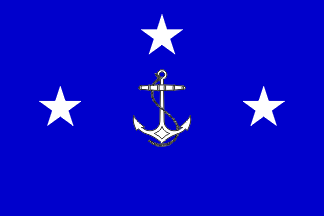 (2:3)
(2:3)
image by Željko Heimer, 22 August 2003
Comandante Naval de Operaciones / Chief of Naval Operations -
According to the Naval Ceremonial and Protocol Regulations number
MAN-EC-CGA-0001-B effective since July 1st, 1997.
Raul Orta, 18 May 2002
According to Album 2000 Corr. 3 [pay03]
- Chief of Naval Operations (2:3) - Blue flag with a white fouled
anchor in the middle and three white five-pointed stars, one
above the anchor, one to the hoist and one to the fly.
Željko Heimer, 22 August 2003
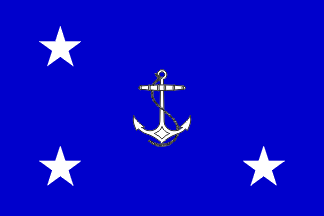 (2:3)
(2:3)
image by Željko Heimer, 22 August 2003
Admiral is quoted in Pavillon 2000 [pay00] as 2:3 but measure 4:5.
Martin Grieve, 7 May 2002
Almirante / Admiral - According to the Naval Ceremonial and
Protocol Regulations number MAN-EC-CGA-0001-B effective since
July 1st, 1997.
Raul Orta, 18 May 2002
According to Album 2000 Corr. 3 [pay03]
- Admiral (2:3) - Blue flag with a white fouled anchor in the
middle and three white five-pointed stars, one in each hoist
corner and one in the fly lower corner.
I suppose that default rank of Chief of Naval
Operations might be that of an admiral (so 3 stars), and that
other admirals use this "default" flag.
Album 95 [pay] is similar to Album
2000. The anchor is also slightly different, including the string
that fouls the anchor reaching further up and crossing back the
vertical beam of the anchor. Similar anchor graphical
represntation is used, if I am not much mistaken, on the rank
insignias in the Venezuelan Navy. I wander if this is here a
mistake or yet an other pattern of the rank flags used before
1997 (possibly much before).
Željko Heimer, 22 and 28 August 2003
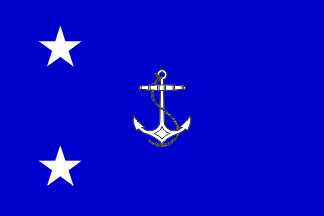 (2:3)
(2:3)
image by Željko Heimer, 22 August 2003
Vice Admiral is quoted in Pavillon 2000 [pay00] as 2:3 but measure 4:5.
Martin Grieve, 7 May 2002
Vicealmirante / Vice-admiral - According to the Naval
Ceremonial and Protocol Regulations number MAN-EC-CGA-0001-B
effective since July 1st, 1997.
Raul Orta, 18 May 2002
According to Album 2000 Corr. 3 [pay03]
- Vice-Admiral (2:3) - Blue flag with a white fouled anchor in
the middle and two white five-pointed stars, one in the hoist top
corner and one in the hoist bottom corner.
The Album has repeated figure number 14 here - the numbers should
be corrected in some future correction, though I am sure that
there are more important things before that comes to it turn.
As I supposed with 3-star flags, I also guss that all 2-star
flags indicate a position of a rank of vice-admiral or equal, at
least by default (it is an other thing that the place might be
filled temporarily by e.g. a rear-admiral), and that this
vice-admiral's flag is used by those Vice-Admirals that do not
have any other prescribed flag. We have listed several other
variants of the 2-star flag, I believe all reported by Raul
Orta following the 1997 regulations: Commander
of the Marine Corps (with rifle over the anchor) , Commander of the Fleet Air Arm (with
wings aroundthe anchor) and Fluvial
Commander (with map of rivers (?) behind the anchor) .
Album 95 [pay] is similar to Album
2000. The anchor is also slightly different, including the string
that fouls the anchor reaching further up and crossing back the
vertical beam of the anchor. Similar anchor graphical
represntation is used, if I am not much mistaken, on the rank
insignias in the Venezuelan Navy. I wander if this is here a
mistake or yet an other pattern of the rank flags used before
1997 (possibly much before).
Željko Heimer, 22 and 28 August 2003
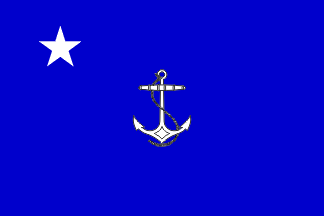 (2:3)
(2:3)
image by Željko Heimer, 22 August 2003
Rear Admiral is quoted in Pavillon 2000 [pay00] as 2:3 but measure 4:5.
Martin Grieve, 7 May 2002
Contralmirante / Rear Admiral - According to the Naval
Ceremonial and Protocol Regulations number MAN-EC-CGA-0001-B
effective since July 1st, 1997.
Raul Orta, 18 May 2002
According to Album 2000 Corr. 3 [pay03]
- Rear-Admiral (2:3) - Blue flag with a white fouled anchor in
the middle and a white five-pointed stars in the hoist top
corner.
Album 95 [pay] is similar to Album
2000. The anchor is also slightly different, including the string
that fouls the anchor reaching further up and crossing back the
vertical beam of the anchor. Similar anchor graphical
represntation is used, if I am not much mistaken, on the rank
insignias in the Venezuelan Navy. I wander if this is here a
mistake or yet an other pattern of the rank flags used before
1997 (possibly much before).
Željko Heimer, 22 and 28 August 2003